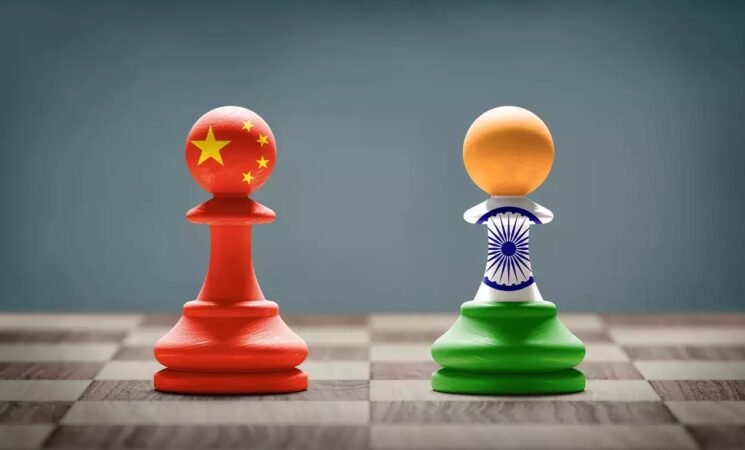26 July 2025, NIICE Commentary 11503
Vidushi Sharma
“Peace is not the absence of conflict, but the ability to cope with it.” - Mahatma Gandhi
At first glance, the recent joint statement from the 34th meeting of the Working Mechanism for Consultation and Coordination (WMCC) on India–China Border Affairs—which included the assertion that both sides were "satisfied with the general prevalence of peace and tranquility" at the Line of Actual Control (LAC)—may appear to be an example of diplomatic boilerplate. However, for long-time observers of the India–China strategic dynamic, this phrase encompasses a shift in the narrative of bilateral relations—from confrontation to a cautious normalization of relations, and from volatility to a managed form of engagement. It is worth teasing apart not only for what it states, but also for what it means, and reveals, concerning the evolving strategic logic of the India–China relationship.
From prima facie, the statement of "peace and tranquility" may sound odd in light of a fully militarized and contested border. This is, after all, the same LAC that saw the killing of 20 Indian soldiers in the June 2020 Galwan clash—the first time in four decades that the armed forces of India and China recorded a fatal engagement. It is the same border area marked by mutual suspicion and enforcement actions amidst a build-up of forward deployments and infrastructure. However, given their historical relationship and the ongoing distrust at play in this area, both sides have made the choice to move back to a discourse of mutual restraint, and more notably, institutional cooperation. In terms of strategy, this action would signify a shift in posture that warrants examination.
The WMCC itself is at the center of this recalibration. Initially developed in 2012 as a tactical de-escalation mechanism and an operational coordinating platform, the WMCC was never meant to provide resolution of the issue—it was merely a mechanism for managing it, which is the purview of the Special Representatives (SR) mechanism. In some ways, it is an institutional firewall: it was a structured system of communication in an attempt to ensure that day-to-day frictions did not develop into crises. The 34th WMCC reveals that while the Smithsonian has put the firewall through its paces in the past several years, it not only withstood the stress test, it also adapted and evolved.
At a structural level, the timing of this WMCC meeting is important. For almost five years since the Galwan clash, India-China relations have been in diplomatic free fall with very few political contacts or trust. The revival of the WMCC and a joint statement of mutual satisfaction with the current status quo is an important step forward and represents a shift in the path when both sides are positively exploring their tactical willingness to move forward from crisis response to a structured management of the India-China norms, an important distinction. This must also be viewed in the larger signaling that is important in the vast complex of strategic concerns. In diplomacy, language matters and carries performative expectations. By stressing that both governments wanted to maintain peace on the LAC, both governments signaled restraint—not just to each other, but also to political and public audiences domestically and globally—that the border dispute does not need to obliterate bilateral relations despite being unresolved.
This shift is not unprecedented. The term "peace and tranquillity" holds historical significance, bound to the 1993 Border Peace and Tranquility Agreement (BPTA), a game-changing agreement that provided the framework for further CBMs and rules of engagement on the LAC. Its revival in 2025 is a conscious rhetorical effort to evoke notions of continuity, stability, and the possibility of a return to a pre-2020 modus vivendi, a status quo that sustained the absence of large-scale violence despite the absence of an agreed border. Effectively, it represents a coded reaffirmation of the post-1993 strategic basis: fractured, but not irreparable.
However, one should be careful not to confuse rhetorical convergence with actual resolution. The basic territorial dispute is still very much alive, and actual movement on the ground - especially in the disputed land at Depsang and Demchok - is limited. Tactical disengagement in parts of the Line of Actual Control hasn't led to strategic de-escalation overall. Troop densities are high, surveillance capabilities are expanding, and infrastructure competition along the LAC is increasing. In this context, "peace and tranquility" becomes less a representation of reality and more a statement of intention - a common desire to not see matters worsen, even without any real resolution.
This is the heart of the WMCC's value. It cannot revise and reestablish borders, nor resolve settlements. It is doing an invaluable service for conflict management by establishing regular, low-risk exchanges. It may not be the prettiest form of diplomacy, but it is the most essential. The WMCC is what international relations scholars call "process-oriented engagement," an approach that prioritizes sustained engagement over breakthrough engagement, and stability over resolution. It is a type of strategic patience designed to buy time, limit risk, and retain options for substantive negotiations at higher levels.
The fact that this meeting also paved the way for the next 24th round of SR-level discussions is indicative of the layered approach to engagement, wherein operational coordination (through the WMCC) supports political negotiation (through the SR mechanism). This bifurcated engagement model is especially appropriate for duration conflicts, where parties wish to take or appear to take maximalist positions and cannot agree immediately in negotiations, but where they have mutual and common interests—e.g., border stability—that allow for a managed form of coexistence. If the WMCC-SR interaction continues to hold, it could provide a model for other bilateral relationships that are prone to conflict.
Some critics argue that such mechanisms are simply fig leaves—quick ways to buy time that don't address the fundamental causes of the dispute. There is truth in that critique. Nevertheless, mechanisms like the WMCC are valuable in time, especially in contested spaces, where trust is low and stakes are high. In those circumstances, time itself is a strategic asset. If mechanisms like the WMCC can delay kinetic escalation, contribute to predictability, and maintain basic levels of communication, then they serve a critical purpose. They may not resolve the dispute, but they will help to prevent it from worsening. In an age where geopolitical flux is on the rise, that is no small ask.
Additionally, the timing of India's resumption of tourist visas for Chinese nationals—immediately announced after the WMCC- adds another layer of nuance. While this may be seen as an administrative move, it is intentionally symbolic. It demonstrates, at least in a political sense, an effort to decouple people-to-people engagement from political tensions, and indicates India's willingness to also engage in a broader normalization agenda. Moreover, Beijing's positive reaction to this demonstrates that both sides are attempting to pursue ways to restore functional normalcy without a comprehensive resolution to border disputes.
The 34th WMCC meeting represents a generational shift, moving towards pre-crisis capabilities and efficiency with "peace and tranquility" as defined space of negotiations, not resolutions. The longer the position or statement is significant, by officially translated diplomatic vocabulary into effective and disciplined action on the terrain and manages the domestic attributes, making WMCC a procedural tool for changing the landscape for security in Asia.
For now, the signals are clear: dialogue is ongoing; tensions are contained; and the long road to resolution remains open. This, in and of itself, is a diplomatic achievement worthy of note and care.
Vidushi Sharma is a Research Intern at NIICE and is currently pursuing her Master's in Political Science in International Relations from Lovely Professional University, Phagwara, India.

